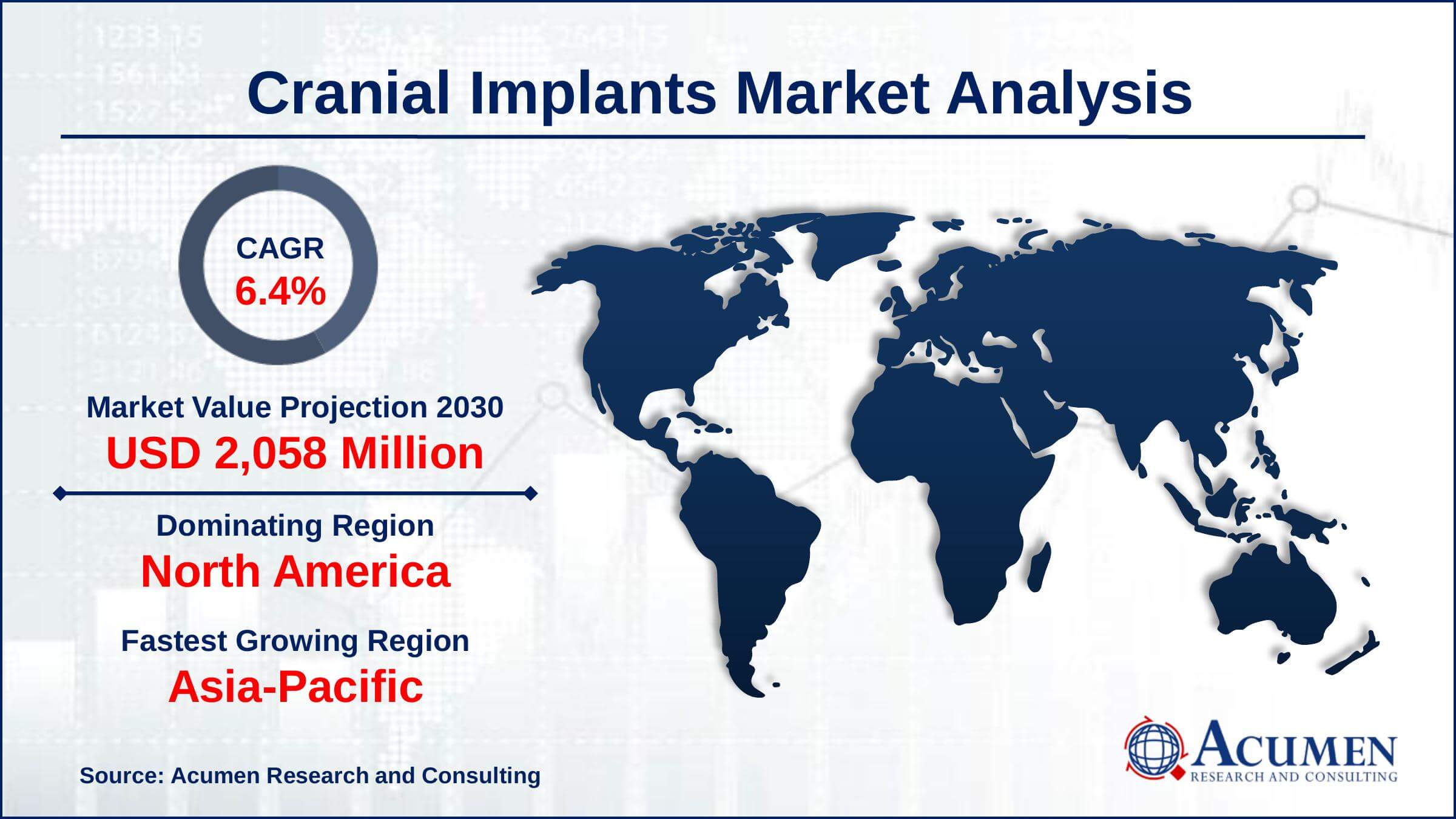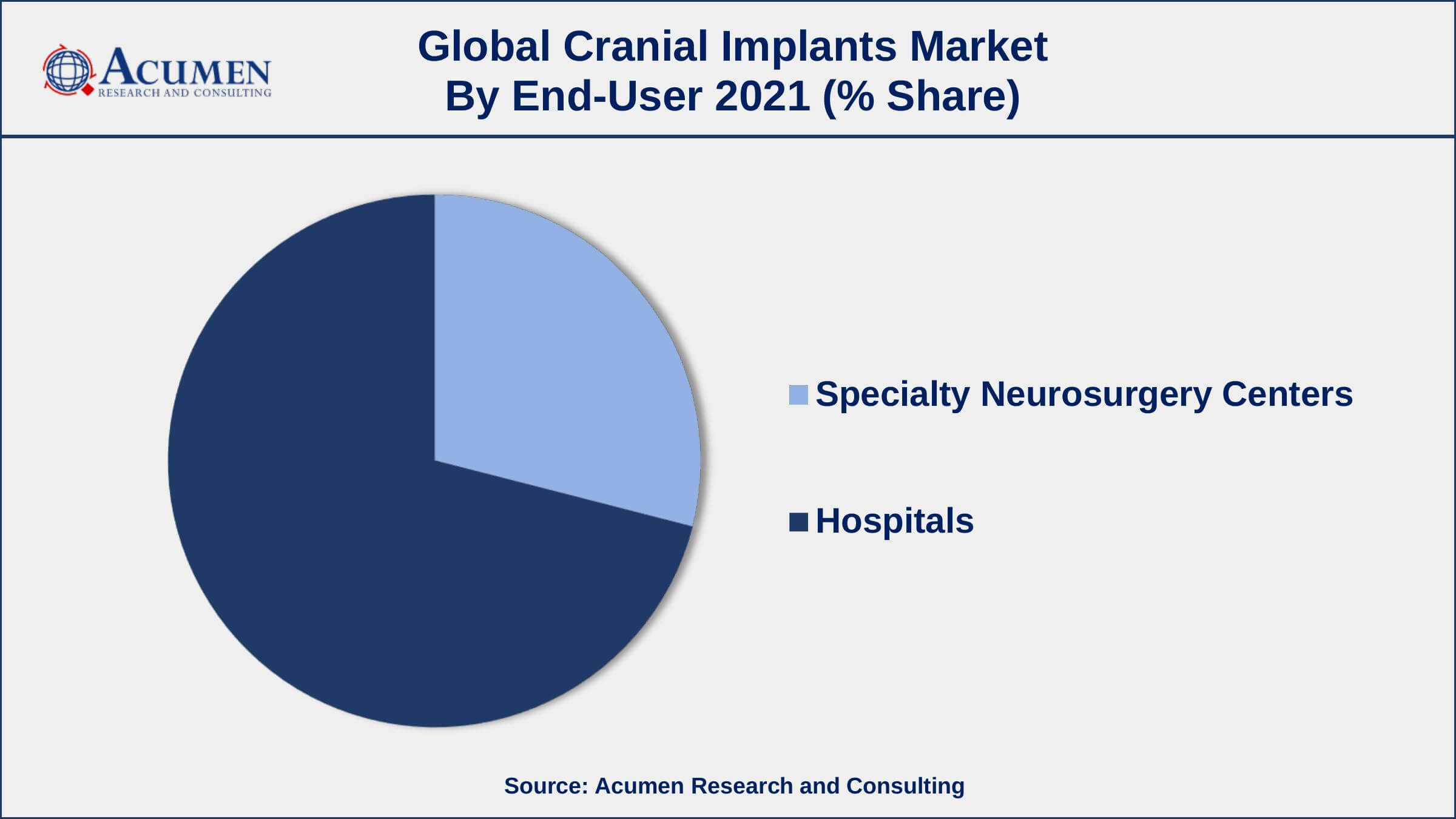Cranial Implants Market Size - Global Industry, Share, Analysis, Trends and Forecast 2022 - 2030
Published :
Report ID:
Pages :
Format :
Cranial Implants Market Size - Global Industry, Share, Analysis, Trends and Forecast 2022 - 2030
Report Coverage
- Industry Dynamics
- Market Size and Forecast Data
- Segment Analysis
- Competitive Landscape
- Regional Analysis with a Niche Focus on Country-Level Data
- High Level Analysis - Porter's, PESTEL, Value Chain, etc.
- Company Profiles of Key Players
- Option to Customize the Report As Per Your Specific Need
Request Sample Report
The Global Cranial Implants Market Size accounted for USD 1,189 Million in 2021 and is estimated to achieve a market size of USD 2,058 Million by 2030 growing at a CAGR of 6.4% from 2022 to 2030. The rising occurrence of neurological illnesses, traumas, wounds, and road accidents, together with expanding professional awareness, is expected to drive the cranial implants market growth. Furthermore, rising government support, paired with growing research activities in technical breakthroughs, propels the cranial implants market value.

Cranial Implants Market Report Key Highlights
- Global cranial implants market revenue is expected to increase by USD 2,058 million by 2030, with a 6.4% CAGR from 2022 to 2030.
- North America region led with more than 36% cranial implants market share in 2021
- Asia-Pacific cranial implants market growth will observe highest CAGR from 2022 to 2030
- By product, the customized cranial implants segment has accounted market share of over 78.9% in 2021
- Among end-user, neurosurgical centers segment is growing at a strongest CAGR over the forecast period
- High predominance of wounds, injuries, and road accidents, drives the cranial implants market size
Cranial implants are implants that are utilized during cranial reconstruction treatments following cranial deformities. Cranial abnormalities are most commonly caused by trauma, infection, or cancer. Facial implantation is employed to enhance specific facial traits. Cranial implants are applied to protect intracranial structures, repair skull shape, normalize cerebral hemodynamics, as well as to aid in cranial reconstruction surgeries following cranial abnormalities. Cranial deformities are typically caused by trauma, infection, and other factors.

Global Cranial Implants Market Trends
Market Drivers
- Increased prevalence of neurological illnesses
- High predominance of wounds, injuries, and road accidents
- Increasing incidence of acquired or congenital deformities
- Rising incidence of cancer and trauma cases
Market Restraints
- High cost of cranioplasty and neurosurgical procedures
- Lack of skilled neurosurgeons
Market Opportunities
- Increasing the number of trauma cases along with the increased geriatric population
- Increased R&D activity and rising public health awareness
Cranial Implants Market Report Coverage
| Market | Cranial Implants Market |
| Cranial Implants Market Size 2021 | USD 1,189 Million |
| Cranial Implants Market Forecast 2030 | USD 2,058 Million |
| Cranial Implants Market CAGR During 2022 - 2030 | 6.4% |
| Cranial Implants Market Analysis Period | 2018 - 2030 |
| Cranial Implants Market Base Year | 2021 |
| Cranial Implants Market Forecast Data | 2022 - 2030 |
| Segments Covered | By Product, By Material, By End-User, And By Geography |
| Regional Scope | North America, Europe, Asia Pacific, Latin America, and Middle East & Africa |
| Key Companies Profiled | Medtronic, Ortho Baltic, Zimmer Biomet, Xilloc Medical B.V., Stryker, KLS Martin Group, Kelyniam Global Inc, DePuySynthes, Medartis, and B. Braun Melsungen AG. |
| Report Coverage |
Market Trends, Drivers, Restraints, Competitive Analysis, Player Profiling, Regulation Analysis |
The global cranial implants market is driven by Increment in the geriatric populace, ascend in the commonness of disease and injury cases, an increment in the number of cranial surgeries look into, and formative exercises in the medicinal services segment in both emerging and emerging nations.
The worldwide cranial implant market is relied upon to be driven by value-added features offered by different cranial embeds so as to give powerful and effective implantation and reclamation. Cranial implants are intended to guarantee expanded achievement rates of medications and fewer complexities. Cranial implants are utilized to fix cranial imperfections happening because of damage, contamination, hemorrhagic ailments, and tumor attack. Cranial implantation happens through cranioplasty, which is a surgical intervention or procedure.
Cranial Implants Market Segmentation
The global cranial implants market segmentation is based on product, material, end-user, and geography.
Cranial Implants Market By Product
- Non-Customized Cranial Implants
- Customized Cranial Implants

According to a cranial implants industry analysis, the customized cranial implants segment dominates the market. Along with this, the non-customized cranial implants segment is relied upon to hold a noteworthy offer of the market, while the altered cranial implants portion is required to extend at a critical CAGR of 7% amid the figure time frame. Customized cranial implants are viewed as explicit and all around fitted as per the cranial deformities, spare working room technique time and help specialists, may render the strategy less intrusive, and decrease the danger of disease and complications. For the most part, non-customized implants include conventional strategies for cranial implantation. The number of non-customized implant products accessible in the market is higher.
Cranial Implants Market By Material
- Ceramic
- Metal
- Polymer
In terms of material, the metal segment is anticipated to hold a major share of the market, while the polymer segment is foreseen to grow at a critical CAGR amid the estimated time frame. The metal segment is assessed to extend at a CAGR of 6.9% amid the gauge time frame. The most ordinarily utilized metal is grade 5 surgical titanium (i.e., Ti-6Al-4V), as a rule, alluded to as 'titanium' or Ti-6-4. Metal is utilized in the head for obsession gadgets (e.g., plates and screws), strong plates, or work, or in combination with different materials, for example, ceramic segments or inactive plastic. The accessibility and long haul achievement rates of metals, for example, titanium, explicitly identified with protection from contaminations, have added to their driving position in the cranial implants market.
Cranial Implants Market By End-user
- Specialty Neurosurgery Centers
- Hospitals

According to the cranial implants market forecast, neurosurgical centers will be the industry's fastest-growing segment in the coming years. This growth is due to the patients' specialized and personalized treatment. Moreover, the improved outcomes in contrast to hospitals are driving demand for neurosurgical facilities. Furthermore, neurosurgery centers make sure that patient-tailored care, resulting in better patient satisfaction.
Cranial Implants Market Regional Outlook
North America
- U.S.
- Canada
Europe
- U.K.
- Germany
- France
- Spain
- Rest of Europe
Asia-Pacific
- India
- Japan
- China
- Australia
- South Korea
- Rest of Asia-Pacific
Latin America
- Brazil
- Mexico
- Rest of Latin America
The Middle East & Africa
- South Africa
- GCC Countries
- Rest of the Middle East & Africa (ME&A)
North America Dominates The Global Market For Cranial Implants
North America is relied upon to overwhelm the worldwide market and record for a prominent share in the coming years. The market in North America is basically determined by a fast increment in the geriatric populace; ascend in the patient populace; high predominance of injury, wounds, road accidents, and cerebrum malignant growth cases; and increment in the acknowledgment of mechanically progressed cranial implants. In addition, an increment in mindfulness among individuals, ascend in the number of players and products, and a significant spotlight on innovative work is foreseen to fuel the worldwide cranial implants market in North America amid the forecast period.
Cranial Implants Market Players
Some of the top cranial implants market companies offered in the professional report include Medtronic, Ortho Baltic, Zimmer Biomet, Xilloc Medical B.V., Stryker, KLS Martin Group, Kelyniam Global Inc, DePuySynthes, Medartis, and B. Braun Melsungen AG.

Frequently Asked Questions
What is the size of global cranial implants market in 2021?
The estimated value of global cranial implants market in 2021 was accounted to be USD 1,189 Million.
What is the CAGR of global cranial implants market during forecast period of 2022 to 2030?
The projected CAGR cranial implants market during the analysis period of 2022 to 2030 is 6.4%.
Which are the key players operating in the market?
The prominent players of the global cranial implants market are Medtronic, Ortho Baltic, Zimmer Biomet, Xilloc Medical B.V., Stryker, KLS Martin Group, Kelyniam Global Inc, DePuySynthes, Medartis, and B. Braun Melsungen AG.
Which region held the dominating position in the global cranial implants market?
North America held the dominating cranial implants during the analysis period of 2022 to 2030.
Which region registered the fastest growing CAGR for the forecast period of 2022 to 2030?
Asia-Pacific region exhibited fastest growing CAGR for cranial implants during the analysis period of 2022 to 2030.
What are the current trends and dynamics in the global cranial implants market?
Increased prevalence of neurological illnesses and high predominance of wounds, injuries, and road accidents drives the growth of global cranial implants market.
By material segment, which sub-segment held the maximum share?
Based on material, customized cranial implants segment is expected to hold the maximum share of the cranial implants market.



